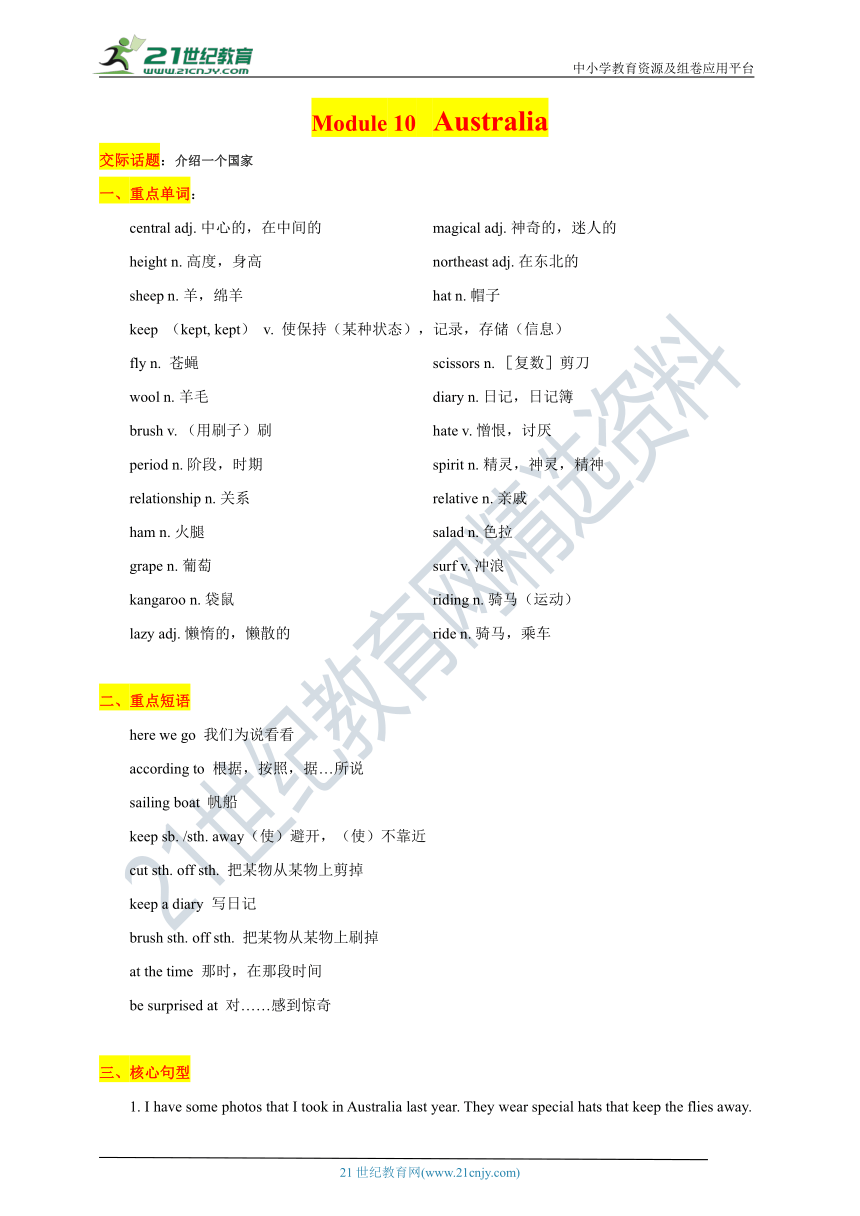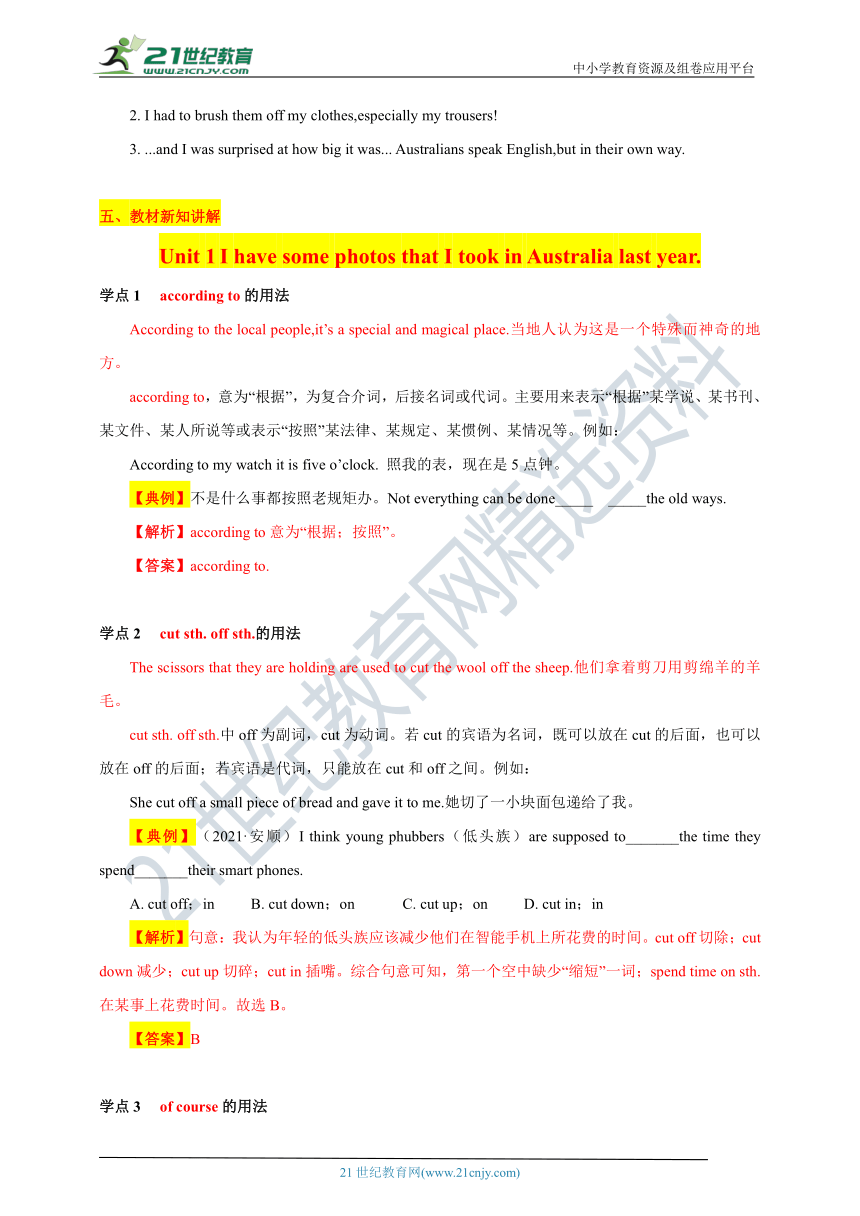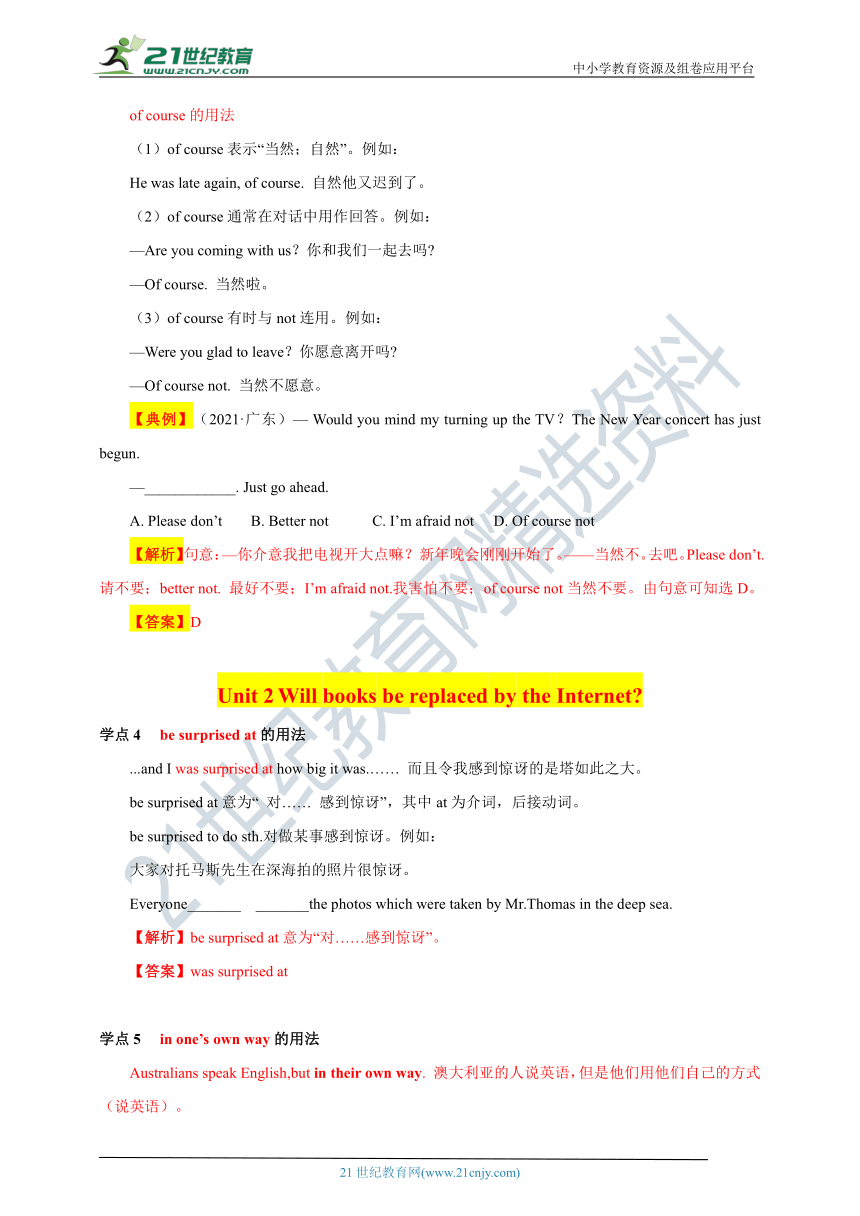Module 10 Australia 精讲学案
文档属性
| 名称 | Module 10 Australia 精讲学案 |

|
|
| 格式 | doc | ||
| 文件大小 | 1.2MB | ||
| 资源类型 | 试卷 | ||
| 版本资源 | 外研版 | ||
| 科目 | 英语 | ||
| 更新时间 | 2021-09-01 06:37:08 | ||
图片预览



文档简介
中小学教育资源及组卷应用平台
Module
10
Australia
交际话题:介绍一个国家
一、重点单词:
central?adj.?中心的,在中间的
magical?adj.?神奇的,迷人的
height?n.?高度,身高
northeast?adj.?在东北的
sheep?n.?羊,绵羊
hat?n.?帽子
keep
(kept,
kept)
v.
使保持(某种状态),记录,存储(信息)
fly
n.
苍蝇
scissors?n.?[复数]剪刀
wool
n.?羊毛
diary?n.?日记,日记簿
brush?v.?(用刷子)刷
hate?v.?憎恨,讨厌
period?n.?阶段,时期
spirit?n.?精灵,神灵,精神
relationship
n.?关系
relative?n.?亲戚
ham
n.?火腿
salad?n.?色拉
grape
n.?葡萄
surf?v.?冲浪
kangaroo
n.?袋鼠
riding?n.?骑马(运动)
lazy?adj.?懒惰的,懒散的
ride?n.?骑马,乘车
二、重点短语
here
we
go
我们为说看看
according
to
根据,按照,据…所说
sailing
boat
帆船
keep
sb.
/sth.
away(使)避开,(使)不靠近
cut
sth.
off
sth.
把某物从某物上剪掉
keep
a
diary
写日记
brush
sth.
off
sth.
把某物从某物上刷掉
at
the
time
那时,在那段时间
be
surprised
at
对……感到惊奇
三、核心句型
1.
I
have
some
photos
that
I
took
in
Australia
last
year.
They
wear
special
hats
that
keep
the
flies
away.
2.
I
had
to
brush
them
off
my
clothes,especially
my
trousers!
3.
...and
I
was
surprised
at
how
big
it
was...
Australians
speak
English,but
in
their
own
way.
五、教材新知讲解
Unit
1
I
have
some
photos
that
I
took
in
Australia
last
year.
学点1
according
to的用法
According
to
the
local
people,it’s
a
special
and
magical
place.当地人认为这是一个特殊而神奇的地方。
according
to,意为“根据”,为复合介词,后接名词或代词。主要用来表示“根据”某学说、某书刊、某文件、某人所说等或表示“按照”某法律、某规定、某惯例、某情况等。例如:
According
to
my
watch
it
is
five
o’clock.
照我的表,现在是5点钟。
【典例】不是什么事都按照老规矩办。Not
everything
can
be
done_____
_____the
old
ways.
【解析】according
to意为“根据;按照”。
【答案】according
to.
学点2
cut
sth.
off
sth.的用法
The
scissors
that
they
are
holding
are
used
to
cut
the
wool
off
the
sheep.他们拿着剪刀用剪绵羊的羊毛。
cut
sth.
off
sth.中off为副词,cut为动词。若cut的宾语为名词,既可以放在cut的后面,也可以放在off的后面;若宾语是代词,只能放在cut和off之间。例如:
She
cut
off
a
small
piece
of
bread
and
gave
it
to
me.她切了一小块面包递给了我。
【典例】(2021·安顺)I
think
young
phubbers(低头族)are
supposed
to_______the
time
they
spend_______their
smart
phones.
A.
cut
off;in
B.
cut
down;on
C.
cut
up;on
D.
cut
in;in
【解析】句意:我认为年轻的低头族应该减少他们在智能手机上所花费的时间。cut
off切除;cut
down减少;cut
up切碎;cut
in插嘴。综合句意可知,第一个空中缺少“缩短”一词;spend
time
on
sth.在某事上花费时间。故选B。
【答案】B
学点3
of
course的用法
of
course的用法
(1)of
course表示“当然;自然”。例如:
He
was
late
again,
of
course.
自然他又迟到了。
(2)of
course通常在对话中用作回答。例如:
—Are
you
coming
with
us?你和我们一起去吗?
—Of
course.
当然啦。
(3)of
course有时与not连用。例如:
—Were
you
glad
to
leave?你愿意离开吗?
—Of
course
not.
当然不愿意。
【典例】(2021·广东)—
Would
you
mind
my
turning
up
the
TV?The
New
Year
concert
has
just
begun.
—____________.
Just
go
ahead.
A.
Please
don’t
B.
Better
not
C.
I’m
afraid
not
D.
Of
course
not
【解析】句意:—你介意我把电视开大点嘛?新年晚会刚刚开始了。——当然不。去吧。Please
don’t.请不要;better
not.
最好不要;I’m
afraid
not.我害怕不要;of
course
not当然不要。由句意可知选D。
【答案】D
Unit
2
Will
books
be
replaced
by
the
Internet?
学点4
be
surprised
at的用法
...and
I
was
surprised
at
how
big
it
was.……
而且令我感到惊讶的是塔如此之大。
be
surprised
at意为“
对……
感到惊讶”,其中at为介词,后接动词。
be
surprised
to
do
sth.对做某事感到惊讶。例如:
大家对托马斯先生在深海拍的照片很惊讶。
Everyone_______
_______the
photos
which
were
taken
by
Mr.Thomas
in
the
deep
sea.
【解析】be
surprised
at意为“对……感到惊讶”。
【答案】was
surprised
at
学点5
in
one’s
own
way的用法
Australians
speak
English,but
in
their
own
way.
澳大利亚的人说英语,但是他们用他们自己的方式(说英语)。
in
one’s
own
way意为“用某人自己的方式”,one’s
随着主语的变化而使用相应的物主代词。
They
can
act
in
their
own
way.他们可以按自己的办法行事。
拓展
on
one’s
way
to意为“某人去做某事的路上”。
【典例】我用我自己的方式学习英语。I
learn
English
_____
_____
_____
_____.
【解析】in
one’s
own
way用自己的方式。
【答案】in
my
own
way
Unit
3
Language
in
use
学点6
brush
sth.
off
sth.的用法
I
had
to
brush
them
off
all
the
time.我不得不一直把它们擦掉。
brush意为“(用刷子)刷”。短语:
brush
sth.
off
sh.把某物从某物上刷掉。例如:
He
brushed
the
dirt
off
his
jacket.
他
拂
去了他夹克上的灰尘。
拓展
brush
off意为“被刷掉”。例如:
Don’t
worry
about
that
mark.It
will
brush
off.
不要为那块污渍担心,它会被刷掉。
【典例】我怎么样才能把墙上的颜色刷掉呢?
How
can
I_____
_____
_____
_____
the
wall?
【解析】brush
sth.
off
sh.把某物从某物上刷掉。
【答案】brush
the
colours
off
五、核心语法
that引导的定语才从句
一个句子跟在一名词或代词(先行词)后进行修饰限定,就叫做定语从句。通俗来讲,从句在整个句子中做定语,这个从句就叫做定语从句。从句在主句中充当定语成分。
被修饰的词叫先行词。定语从句不同于单词作定语的情况,它通常只能放在被修饰的词(即先行词)之后。
that常用作关系代词,可指代某人,也可指代某物,指物时有的时候可用which替换that,指人时可用who替换。但在下列情况下,一般用that。
(1)先行词为all,
few,
little,
much,
the
one,
something,
anything,
everything,
nothing
等时。例如:
We’ll
do
all
that
we
can
to
protect
the
endangered
plants
and
animals.
我们将尽我们的最大努力来保护那些濒危的动植物。
(2)先行词被all,
every,
no,
some,
any,(a)few,
(a)little,
much等限定词修饰时。例如:
You
can
borrow
any
book
that
you
want
to
read
in
our
school
library.在我们图书馆,你可以借任何你想读的书。
(3)先行词被序数词或形容词最高级修饰时。例如:
This
is
the
most
beautiful
city
that
I’ve
ever
seen.这是我见过的最漂亮的城市。
(4)先行词被the
only,
the
very,
the
right,
the
last
等修饰时。例如:
This
is
the
very
factory
that
they
visited
last
summer
holiday.
这恰好是他们去年参观的那个工厂。
(5)先行词是并列结构,既有人又有物时。例如:
He
talked
happily
of
the
writer
and
his
books
that
interested
him.他兴高采烈地谈论着那位作家和他感兴趣的书。
(6)先行词前有the
same
修饰,表示和先行词是同一物时。例如:
This
is
the
same
purse
as
I
lost
yesterday.
这个钱夹和我昨天丢的那个一样。
(7)先行词为数词时。
Look
at
the
books
on
the
bookshelf.
You
can
see
the
two
that
you
bought
me
for
my
birthday.
书架上那些书。你可以看到我过生日时你买的那两本。
核心素养在线
本模块的话题是介绍一个国家。通过对本模块的学习旨在培养学生的责任感、国际视野和家国情怀。作为今天的中国人,我们需要谨记社会主义核心价值观,用爱国的优良传统、敬业的奋斗精神、诚信的做人原则、友爱的团结作风,撑起富民强国的中国梦!
(2021·广东)
Tony:Hello,
Mike.
The
weekend
is
coming.
1.___________________.
Mike:Yes,
I’d
love
to.
2.
___________________.
Tony:What
about
the
Palace
Museum?There
is
a
great
show
there.
Mike:That’s
really
a
wonderful
place
to
visit.
3.
___________________.
Tony:We
can
see
fine
works
of
art
there.
Mike:That
sounds
great.
4.
___________________
.
Tony:
The
best
way
is
to
take
the
underground.
It
takes
only
20
minutes.
Mike:All
right.
5.
___________________.
Tony:Shall
we
meet
at
my
home
at
8
am
tomorrow?
Mike:OK,
see
you
tomorrow.
Tony:See
you.
A.Would
you
like
to
go
on
a
trip
with
me?
B.Who
will
go
with
us?
C.How
can
we
go
there?
D.When
and
where
shall
we
meet?
E.
Then
what
can
we
do
there?
F.
But
where
shall
we
go?
这则对话就周末去故宫的旅行展开了交流。
1.A句意:你想和我一起去旅行吗?由答句的Yes,
I’d
love
to(是的,我愿意)知道前句是在问“愿不愿意一起去旅行”。故选A。
2.F句意:但我们到哪儿去?由答句的建议“
故宫怎么样?”
得知前句是在问“去哪里”。故选F。
3.E句意:在那我们能做什么呢?由答句“我们能在那里看到优质的艺术品”得知前句是在问“去那里能干嘛”。故选E。
4.C句意:我们怎么去那里?由答句的“最佳方式是坐地铁”得知前句是在问去那里的方式。故选C。
5.D句意:我们何时何地见面?由答句的建议“我们要不明天早上八点在我家见面?”得知是在问何时何地见面。故选D。
21世纪教育网
www.21cnjy.com
精品试卷·第
2
页
(共
2
页)
HYPERLINK
"http://21世纪教育网(www.21cnjy.com)
"
21世纪教育网(www.21cnjy.com)
Module
10
Australia
交际话题:介绍一个国家
一、重点单词:
central?adj.?中心的,在中间的
magical?adj.?神奇的,迷人的
height?n.?高度,身高
northeast?adj.?在东北的
sheep?n.?羊,绵羊
hat?n.?帽子
keep
(kept,
kept)
v.
使保持(某种状态),记录,存储(信息)
fly
n.
苍蝇
scissors?n.?[复数]剪刀
wool
n.?羊毛
diary?n.?日记,日记簿
brush?v.?(用刷子)刷
hate?v.?憎恨,讨厌
period?n.?阶段,时期
spirit?n.?精灵,神灵,精神
relationship
n.?关系
relative?n.?亲戚
ham
n.?火腿
salad?n.?色拉
grape
n.?葡萄
surf?v.?冲浪
kangaroo
n.?袋鼠
riding?n.?骑马(运动)
lazy?adj.?懒惰的,懒散的
ride?n.?骑马,乘车
二、重点短语
here
we
go
我们为说看看
according
to
根据,按照,据…所说
sailing
boat
帆船
keep
sb.
/sth.
away(使)避开,(使)不靠近
cut
sth.
off
sth.
把某物从某物上剪掉
keep
a
diary
写日记
brush
sth.
off
sth.
把某物从某物上刷掉
at
the
time
那时,在那段时间
be
surprised
at
对……感到惊奇
三、核心句型
1.
I
have
some
photos
that
I
took
in
Australia
last
year.
They
wear
special
hats
that
keep
the
flies
away.
2.
I
had
to
brush
them
off
my
clothes,especially
my
trousers!
3.
...and
I
was
surprised
at
how
big
it
was...
Australians
speak
English,but
in
their
own
way.
五、教材新知讲解
Unit
1
I
have
some
photos
that
I
took
in
Australia
last
year.
学点1
according
to的用法
According
to
the
local
people,it’s
a
special
and
magical
place.当地人认为这是一个特殊而神奇的地方。
according
to,意为“根据”,为复合介词,后接名词或代词。主要用来表示“根据”某学说、某书刊、某文件、某人所说等或表示“按照”某法律、某规定、某惯例、某情况等。例如:
According
to
my
watch
it
is
five
o’clock.
照我的表,现在是5点钟。
【典例】不是什么事都按照老规矩办。Not
everything
can
be
done_____
_____the
old
ways.
【解析】according
to意为“根据;按照”。
【答案】according
to.
学点2
cut
sth.
off
sth.的用法
The
scissors
that
they
are
holding
are
used
to
cut
the
wool
off
the
sheep.他们拿着剪刀用剪绵羊的羊毛。
cut
sth.
off
sth.中off为副词,cut为动词。若cut的宾语为名词,既可以放在cut的后面,也可以放在off的后面;若宾语是代词,只能放在cut和off之间。例如:
She
cut
off
a
small
piece
of
bread
and
gave
it
to
me.她切了一小块面包递给了我。
【典例】(2021·安顺)I
think
young
phubbers(低头族)are
supposed
to_______the
time
they
spend_______their
smart
phones.
A.
cut
off;in
B.
cut
down;on
C.
cut
up;on
D.
cut
in;in
【解析】句意:我认为年轻的低头族应该减少他们在智能手机上所花费的时间。cut
off切除;cut
down减少;cut
up切碎;cut
in插嘴。综合句意可知,第一个空中缺少“缩短”一词;spend
time
on
sth.在某事上花费时间。故选B。
【答案】B
学点3
of
course的用法
of
course的用法
(1)of
course表示“当然;自然”。例如:
He
was
late
again,
of
course.
自然他又迟到了。
(2)of
course通常在对话中用作回答。例如:
—Are
you
coming
with
us?你和我们一起去吗?
—Of
course.
当然啦。
(3)of
course有时与not连用。例如:
—Were
you
glad
to
leave?你愿意离开吗?
—Of
course
not.
当然不愿意。
【典例】(2021·广东)—
Would
you
mind
my
turning
up
the
TV?The
New
Year
concert
has
just
begun.
—____________.
Just
go
ahead.
A.
Please
don’t
B.
Better
not
C.
I’m
afraid
not
D.
Of
course
not
【解析】句意:—你介意我把电视开大点嘛?新年晚会刚刚开始了。——当然不。去吧。Please
don’t.请不要;better
not.
最好不要;I’m
afraid
not.我害怕不要;of
course
not当然不要。由句意可知选D。
【答案】D
Unit
2
Will
books
be
replaced
by
the
Internet?
学点4
be
surprised
at的用法
...and
I
was
surprised
at
how
big
it
was.……
而且令我感到惊讶的是塔如此之大。
be
surprised
at意为“
对……
感到惊讶”,其中at为介词,后接动词。
be
surprised
to
do
sth.对做某事感到惊讶。例如:
大家对托马斯先生在深海拍的照片很惊讶。
Everyone_______
_______the
photos
which
were
taken
by
Mr.Thomas
in
the
deep
sea.
【解析】be
surprised
at意为“对……感到惊讶”。
【答案】was
surprised
at
学点5
in
one’s
own
way的用法
Australians
speak
English,but
in
their
own
way.
澳大利亚的人说英语,但是他们用他们自己的方式(说英语)。
in
one’s
own
way意为“用某人自己的方式”,one’s
随着主语的变化而使用相应的物主代词。
They
can
act
in
their
own
way.他们可以按自己的办法行事。
拓展
on
one’s
way
to意为“某人去做某事的路上”。
【典例】我用我自己的方式学习英语。I
learn
English
_____
_____
_____
_____.
【解析】in
one’s
own
way用自己的方式。
【答案】in
my
own
way
Unit
3
Language
in
use
学点6
brush
sth.
off
sth.的用法
I
had
to
brush
them
off
all
the
time.我不得不一直把它们擦掉。
brush意为“(用刷子)刷”。短语:
brush
sth.
off
sh.把某物从某物上刷掉。例如:
He
brushed
the
dirt
off
his
jacket.
他
拂
去了他夹克上的灰尘。
拓展
brush
off意为“被刷掉”。例如:
Don’t
worry
about
that
mark.It
will
brush
off.
不要为那块污渍担心,它会被刷掉。
【典例】我怎么样才能把墙上的颜色刷掉呢?
How
can
I_____
_____
_____
_____
the
wall?
【解析】brush
sth.
off
sh.把某物从某物上刷掉。
【答案】brush
the
colours
off
五、核心语法
that引导的定语才从句
一个句子跟在一名词或代词(先行词)后进行修饰限定,就叫做定语从句。通俗来讲,从句在整个句子中做定语,这个从句就叫做定语从句。从句在主句中充当定语成分。
被修饰的词叫先行词。定语从句不同于单词作定语的情况,它通常只能放在被修饰的词(即先行词)之后。
that常用作关系代词,可指代某人,也可指代某物,指物时有的时候可用which替换that,指人时可用who替换。但在下列情况下,一般用that。
(1)先行词为all,
few,
little,
much,
the
one,
something,
anything,
everything,
nothing
等时。例如:
We’ll
do
all
that
we
can
to
protect
the
endangered
plants
and
animals.
我们将尽我们的最大努力来保护那些濒危的动植物。
(2)先行词被all,
every,
no,
some,
any,(a)few,
(a)little,
much等限定词修饰时。例如:
You
can
borrow
any
book
that
you
want
to
read
in
our
school
library.在我们图书馆,你可以借任何你想读的书。
(3)先行词被序数词或形容词最高级修饰时。例如:
This
is
the
most
beautiful
city
that
I’ve
ever
seen.这是我见过的最漂亮的城市。
(4)先行词被the
only,
the
very,
the
right,
the
last
等修饰时。例如:
This
is
the
very
factory
that
they
visited
last
summer
holiday.
这恰好是他们去年参观的那个工厂。
(5)先行词是并列结构,既有人又有物时。例如:
He
talked
happily
of
the
writer
and
his
books
that
interested
him.他兴高采烈地谈论着那位作家和他感兴趣的书。
(6)先行词前有the
same
修饰,表示和先行词是同一物时。例如:
This
is
the
same
purse
as
I
lost
yesterday.
这个钱夹和我昨天丢的那个一样。
(7)先行词为数词时。
Look
at
the
books
on
the
bookshelf.
You
can
see
the
two
that
you
bought
me
for
my
birthday.
书架上那些书。你可以看到我过生日时你买的那两本。
核心素养在线
本模块的话题是介绍一个国家。通过对本模块的学习旨在培养学生的责任感、国际视野和家国情怀。作为今天的中国人,我们需要谨记社会主义核心价值观,用爱国的优良传统、敬业的奋斗精神、诚信的做人原则、友爱的团结作风,撑起富民强国的中国梦!
(2021·广东)
Tony:Hello,
Mike.
The
weekend
is
coming.
1.___________________.
Mike:Yes,
I’d
love
to.
2.
___________________.
Tony:What
about
the
Palace
Museum?There
is
a
great
show
there.
Mike:That’s
really
a
wonderful
place
to
visit.
3.
___________________.
Tony:We
can
see
fine
works
of
art
there.
Mike:That
sounds
great.
4.
___________________
.
Tony:
The
best
way
is
to
take
the
underground.
It
takes
only
20
minutes.
Mike:All
right.
5.
___________________.
Tony:Shall
we
meet
at
my
home
at
8
am
tomorrow?
Mike:OK,
see
you
tomorrow.
Tony:See
you.
A.Would
you
like
to
go
on
a
trip
with
me?
B.Who
will
go
with
us?
C.How
can
we
go
there?
D.When
and
where
shall
we
meet?
E.
Then
what
can
we
do
there?
F.
But
where
shall
we
go?
这则对话就周末去故宫的旅行展开了交流。
1.A句意:你想和我一起去旅行吗?由答句的Yes,
I’d
love
to(是的,我愿意)知道前句是在问“愿不愿意一起去旅行”。故选A。
2.F句意:但我们到哪儿去?由答句的建议“
故宫怎么样?”
得知前句是在问“去哪里”。故选F。
3.E句意:在那我们能做什么呢?由答句“我们能在那里看到优质的艺术品”得知前句是在问“去那里能干嘛”。故选E。
4.C句意:我们怎么去那里?由答句的“最佳方式是坐地铁”得知前句是在问去那里的方式。故选C。
5.D句意:我们何时何地见面?由答句的建议“我们要不明天早上八点在我家见面?”得知是在问何时何地见面。故选D。
21世纪教育网
www.21cnjy.com
精品试卷·第
2
页
(共
2
页)
HYPERLINK
"http://21世纪教育网(www.21cnjy.com)
"
21世纪教育网(www.21cnjy.com)
同课章节目录
- Module 1 Wonders of the world
- Unit 1 It's more than 2,000 years old.
- Unit 2 The Grand Canyon was not just big.
- Unit 3 Language in use
- Module 2 Public holidays
- Unit 1 My family always go somewhere interesting a
- Unit 2 We have celebrated the festival since the f
- Unit 3 Language in use
- Module 3 Heroes
- Unit 1 She trained hard,so she became a great play
- Unit 2There were few doctors, so he had to work ve
- Unit 3 Language in use
- Module 4 Home alone
- Unit 1 I can look after myself, although it won’t
- Unit 2 I became so bored with their orders that I
- Unit 3 Language in use
- Module 5 Museums
- Unit 1 Don't cross that rope!
- Unit 2 If you ever go to London, make sure you vis
- Unit 3 Language in use
- Module 6 Problems
- Unit 1 If I start after dinner, I'll finish it be
- Unit 2 If you tell him the truth now, you will sho
- Unit 3 Language in use
- Revision Module A
- Module 7 Great books
- Unit 1 We're still influenced by Confucius's idea
- Unit 2 It is still read and loved.
- Unit 3 Language in use
- Module 8 Sports life
- Unit 1 Daming wasn't chosen for the team last time
- Unit 2 He was invited to competitions around the w
- Unit 3 Language in use
- Module 9 Great inventions
- Unit 1 Will computers be used more than books in t
- Unit 2 Will books be replaced by the Internet?
- Unit 3 Language in use
- Module 10 Australia
- Unit 1 I have some photos that I took in Australia
- Unit 2 The game that they like most is Australian
- Unit 3 Language in use
- Module 11 Photos
- Unit 1 He's the boy who won the photo competition
- Unit 2 The photo which we liked best was taken by
- Unit 3 Language in use
- Module 12 Save our world
- Unit 1 If everyone starts to do something, the wor
- Unit 2 Repeat these three words daily: reduce, reu
- Unit 3 Language in use
- Revision Module B
